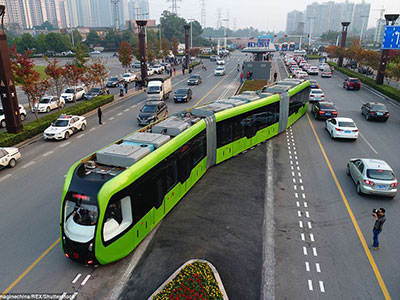Integration with Viva Highway 7 BRT and Dedicated Lanes
The current Züm service along the Queen Street/Highway 7 corridor offers a continuous, inter-regional connection between Downtown Brampton, Vaughan Metropolitan Centre, and York University.

The most popular service operated by Brampton Transit

~19,000 boardings on a typical weekday (Fall 2017)

Weekday ridership grew on average 7% per year between 2011 and 2017.
The 2013 Benefits Case Analysis (BCA) found that the most important outcome of a Queen Street/Highway 7 rapid transit corridor is to provide continuous service. For example, forcing customers to transfer from a light rail vehicle in Brampton to another service provider midpoint in their journey, will make rapid transit unattractive to riders, not offering any benefits over the existing Züm service in mixed traffic. This will result in less ridership potential for the corridor, a finding reaffirmed by this study.
York Region and Metrolinx are currently implementing dedicated transit lanes (branded “Rapidway”) for BRT operation along the Highway 7 East and Highway 7 West corridors. Construction is currently underway along the Highway 7 West corridor between Richmond Hill Centre and Helen Street/Bruce Street in Vaughan. Züm service on Highway 7 is planned to operate on the new Rapidway upon completion.
York Region is currently working to secure funding to extend the Highway 7 West Rapidway from Helen Street to Highway 50 for BRT operation. As such, it would be important for Queen Street Rapid Transit to share a common transit mode with York Region Transit’s VIVA BRT.


Flexibility
BRT accounts for physical constraints within the Downtown Brampton area. With major transformations underway in the downtown area (Downtown Reimagine Project, Ryerson University campus, the future Centre for Innovation, and the potential future expansion of the Downtown Transit Terminal), the preferred solution for Queen Street Rapid Transit would need to be operationally flexible to respond to the changing landscape of the downtown. BRT is advantageous because it is operationally flexible, less infrastructure-intensive, and less costly to implement.
Future Ready
While BRT is the proposed starting point for Queen Street Rapid Transit, an important requirement for the project will be that the design of the corridor allows for future upgrades in capacity, infrastructure, technology (e.g. electric propulsion, vehicular automation, autonomous vehicles, Smart Lanes), or conversion to light rail if warranted. Recognizing the emergence of new and evolving transit technologies in the industry, the proposed transit solution is flexible enough to adapt to the changing technological environment.
Electric Buses


High Capacity Buses


Vehicular Automation, Autonomous Technology


